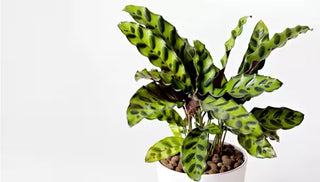Named for the manner in which their leaves fold together in the evening (a physiological response known as "nyctinasty"), prayer plants are a favorite amongst plant parents of all abilities. Prayer plants (Maranta leuconeura) are primarily native to the tropics of South America, where they flourish on the rainforest floor. There, they bask under dappled sunlight in hot, moist air — mimic these conditions at home, and you'll have no problem caring for this gorgeous houseplant!
It should be noted that "prayer plant" is often used as an all-encompassing common name for several different genuses of plants, including Calathea spp., Stromanthe spp., and this one described here (Maranta spp.). They are all members of the Marantaceae family, but entirely separate genuses — in simple terms, these plants are all related, but different!
Types of Prayer Plant To Try
As houseplants, prayer plants are prized for their paddle-shaped leaves, which feature bold patterns of green, red, pink, and white. Varieties and cultivars of this species are distinguished from the species by leaf patterns and leaf coloration.
Maranta leuconeura ‘Erythroneura’: also known as the red prayer plant, this variety has dark leaves with striking red veining and patches of light green
Maranta leuconeura ‘Lemon Lime’: similar to 'Erythroneura', this variety has vibrant lime green veining instead of red
Maranta leuconeura ‘Kerchoveana’: light gray-green leaves sport deeper green splotches; commonly referred to as the rabbits foot plant or green prayer plant
Best Conditions For Prayer Plants
Light
Prayer plants thrive in medium to low indirect light. In their native habitat, prayer plants receive dappled sunlight filtering down through the tree canopy. In your home, place them near east or north-facing windows where they can receive gentle morning light or filtered afternoon light.
Soil
A well-draining, peat-based potting mix is suitable for prayer plants. They prefer a slightly acidic to neutral pH. Fertilize your prayer plants every two weeks during the growing season with a half-strength balanced liquid fertilizer, and reduce feeding in the winter months.
Humidity
As a tropical native, prayer plants love high humidity. Keep them in a steamy bathroom, set them on a pebble-filled dish of water, or set them near a humidifier. Browning leaf tips are an indicator that the air is too dry, and your prayer plant needs an increase in humidity.
How To Care For Prayer Plants
Watering
Water prayer plants when the top inch of soil feels dry to the touch. They prefer consistent moisture but are sensitive to overwatering, which can lead to root rot. Proper humidity is nearly as important as soil moisture for these tropical rainforest natives.
Pruning
While prayer plants don’t require heavy pruning, occasional trimming can keep them looking tidy. Remove any yellow or damaged leaves at the base of the stem with clean scissors.
Repotting
Repot your prayer plant every 1-2 years, or when it outgrows its pot. Choose a container that is only slightly larger than the previous one to avoid excessive moisture retention in the soil.
Propagation
Prayer plants can be propagated by division. When repotting, gently divide the plant into sections, ensuring each has a part of the root system, and plant them in separate pots. Keep new baby prayer plants warm and moist until their roots develop and additional leaves mature.
Common Problems with Prayer Plants
Pests and Diseases
The most common pests to watch for are spider mites and mealybugs. Keep an eye out for signs of infestation, such as webbing or cotton-like substances on the plants. As for diseases, overwatering can lead to root rot, so it's crucial to maintain a proper watering schedule.
Toxicity
One of the great benefits of prayer plants is their non-toxic nature, making them safe for homes with pets and children.
Prayer Plants FAQs
Q: Why are the tips of my prayer plant's leaves turning brown?
A: Brown tips can be a sign of low humidity or inconsistent watering. Try increasing the humidity around the plant with a humidifier or a pebble tray filled with water.
Q: How often should I water my prayer plant?
A: The frequency of watering depends on factors like light, temperature, and humidity. Generally, water when the top inch of the soil feels dry. Ensure the pot has good drainage to prevent waterlogging.
Q: Are prayer plants easy to care for?
A: Prayer plants don't require much daily fussing, however they do like consistently warm temperatures and high humidity levels — try to imitate this tropical rainforest vibe, and your prayer plant will do just fine.
Bring a touch of the tropics to your home! The prayer plant's daily leaf movements and stunning foliage is sure to fill your indoor garden with ever-changing beauty.




